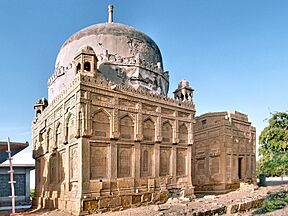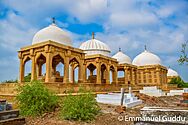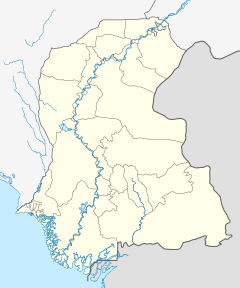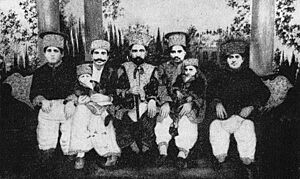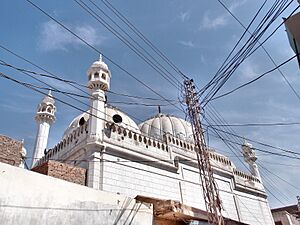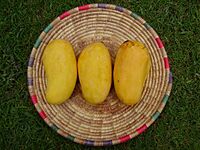Mirpur Khas facts for kids
Quick facts for kids
Mirpur Khas
ميرپورخاص
Mīrpur Khās
|
|
|---|---|
|
Clockwise from top: The 17th century Tomb of Tharo Khan, Chittori Tombs, and major monuments of Mirpur Khas, excavation of a Brahma bronze
|
|
| Country | |
| Province | |
| Division | Mirpur Khas |
| District | Mirpur Khas |
| Government | |
| • Type | Municipal Corporation |
| Population
(2023 census)
|
|
| • City | 267,833 |
| • Rank | 74th, Pakistan |
| Time zone | UTC+5 (PKT) |
| Postal code |
69000
|
| Calling code | 0233 |
| Number of towns | 10 |
Mirpur Khas is a city in the Sindh province of Pakistan. Its name means "Town of the most-high Mirs" in Sindhi and Urdu: میرپور خاص. The city was built by the Talpur rulers from the Mankani family. In 2017, about 205,913 people lived here.
Mirpur Khas is famous for its mango farms. People grow hundreds of different types of mangoes here every year. Because of this, it's often called the “City of Mangoes.” Since 1955, the city has hosted an annual mango festival. A new highway connecting it to Hyderabad has also made Mirpur Khas a busy place for business.
Contents
Exploring Mirpur Khas History
Ancient Times and Early Settlers
People have lived in the Mirpur Khas area for thousands of years. We know this from old discoveries like the Buddhist settlement of Kahoo Jo Daro and several ancient Hindu temples. You can still see parts of these old buildings today.
A very old Bronze statue of the Hindu god Brahma was found here. It dates back to the Gupta period (5th or 6th century). This is the earliest known metal image of Brahma and is considered a great piece of art from that time. In 712 CE, armies led by Muhammad Bin Qasim took over this region.
How Mirpur Khas Was Founded
The Talpur dynasty took control of Sindh in 1784. Under Mir Fath Ali Khan, Sindh was split into three smaller areas. Each area was ruled by a different part of the Talpur family. These three areas were centered around Hyderabad, Khairpur, and Mirpur Khas.
In 1801, the Mankani branch of the family, led by Mir Ali Murad Talpur, took charge of the Mirpur Khas region. He decided to build a new city, Mirpur Khas, in 1806. This new city became the capital of their area.
The Mirpur Khas State
Mir Sher Muhammad Talpur became the ruler after Mir Ali Murad (from 1829 to 1843). He built a fort in the city and held his court (a kutchery) inside it. Special graves for the local rulers were built at Chitorri. These graves show a mix of building styles, combining Islamic and Rajasthani designs.
Mirpur Khas was the capital for the Talpur Mirs until 1843. That year, Charles James Napier and the East India Company took over Sindh. They defeated Mir Sher Muhammad Talpur on March 24, 1843, at the battleground of Dubbo. Because of his fight for Sindh, Mir Sher Muhammad Talpur was known as the "Lion of Sindh."
Mirpur Khas Under British Rule
After Sindh became part of British India, Mirpur Khas was first part of the Bombay Presidency. The town of Umerkot was the main city for the Thar and Parkar district. Mirpur Khas wasn't as important until a railway line was built. This line connected the city to the Jodhpur-Bikaner Railway.
When the Jamrao Canal opened in 1900, Mirpur Khas became much more important than other towns in the district. It became a municipality (a self-governing town) in 1901. In 1906, the main district office moved from Umerkot to Mirpur Khas.
After Pakistan's Independence
After Pakistan became independent in 1947, Mirpur Khas was the first city to welcome refugees from India. This was because it was close to the Indian border. It became a key railway stop for the first trains coming from Rajasthan into Sindh.
Many Hindu people living in the city moved away after the partition. However, Mirpur Khas and most of Sindh did not have the widespread violence seen in other areas like Punjab and Bengal. Fewer than 500 Hindus were killed in all of Sindh between 1947-48. Sindhi Muslims mostly did not turn against their Hindu neighbors. Hindus did not leave Sindh in large numbers until riots happened in Karachi in January 1948. Even though those riots were local, they made Hindus in Sindh afraid. Today, about 35% of Mirpur Khas District's population is Hindu.
Large numbers of refugees from India kept arriving in the city after 1947. This caused the population to grow very quickly and changed who lived there. In 1951, the city had 40,420 people. About 68% of them were Urdu-speaking refugees from India. This was the highest percentage in any major city in Sindh. By 1961, the population grew to 60,861. In 1990, the Mirpur Khas area became its own district, separate from Thar and Parkar.
Cricket History
In 1976/77, a World XI cricket team played a match in Gama Stadium, Mirpurkhas, and won. Soon after, a match was played between Sind XI and Sri Lanka XI, which Sri Lanka XI won.
Geography of Mirpur Khas
Mirpur Khas is located in the southeastern part of Sindh, on the Let Wah Canal at 25°31′39.3″N 69°00′50.6″E / 25.527583°N 69.014056°E. It is about 65 kilometers east of Hyderabad. A four-lane highway and a railway connect it to Hyderabad. The N120 Highway links it to Umerkot. Karachi is about 220 kilometers southwest of Mirpur Khas. The border with India is about 170 kilometers east of the city.
People and Languages
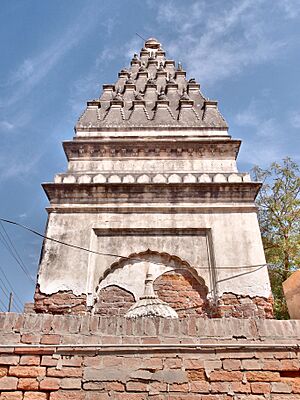
The city of Mirpur Khas has a different mix of people compared to the whole district. In 2017, the city had 234,133 people. For every 1000 males, there were 949 females. The literacy rate (people who can read and write) was 75.62%. For males, it was 80.27%, and for females, it was 70.74%. About 54,045 people (23.08%) were under 10 years old.
| Religions in Mirpur Khas MC (2017) | ||||
|---|---|---|---|---|
| Religion | Percent | |||
| Islam | 90.02% | |||
| Hinduism | 8.03% | |||
| Christianity | 1.69% | |||
| Other or not stated | 0.26% | |||
In 2017, most people (59.31%) spoke Sindhi as their first language. Other languages spoken were Urdu (20.66%), Punjabi (10.15%), Balochi (4.73%), Pashto (2.19%), and Saraiki (0.99%).
Mirpur Khas is home to several well-known Sindhi Muslim groups like the Soomras, Khaskhelis, Mallah, Dharejo, Junejo, Rajper, and Samejo. There is also a large group of Sindhi Hindus in Mirpur Khas, many of whom are involved in business.
In the late 1700s, many Muslim families moved to this area from eastern Punjab. The largest group was the Arain community. They came from places like Amritsar, Gurdaspur, Ferozpur, Ambala, Patiala, and Jalandhar in the Punjab. Near Mirpur Khas, there is an old Sikh temple called the Gurdwara Pehli Patshahi. It is believed that Guru Nanak, the founder of Sikhism, once visited this spot.
Education in Mirpur Khas
Universities and Colleges
Mirpur Khas has several universities and college campuses:
- University of Mirpurkhas
- Ibn-e-Sina University, Mirpurkhas
- Sukkur IBA Mirpurkhas campus
- Bhitai Dental and Medical College
- Muhammad Medical College
- SZABIST College Mirpurkhas
The city has many government colleges, most of which are connected to the University of Sindh. Mirpur Khas also has two private medical colleges, Muhammad Medical College and Bhitai Dental and Medical College, which are approved by the PMDC.
The University of Mirpurkhas offers five different degree programs: BS-Information Technology, BS-Computer Science, BS-Commerce, BBA, and BS-Geology.
Schools and Learning Centers
Mirpur Khas has many schools, both private and public. The number of private schools has grown a lot in the last ten years. Some well-known schools include The Vision School Mirpurkhas, Fauji Foundation Model School, The City School, SZABIST School & College, Little Folks High School, Govt: S.A.L College, AJ Science College, and the famous Bahria Foundation College, which is a project of the Pakistan Navy.
The city also has many tuition centers. These centers help students, especially those in grades IX, X, XI, and XII. They also prepare students for important entry tests like the MCAT (Medical College Admission Test) and ECAT (Engineering College Admission Test).
Mirpur Khas city now has its own examination board called BISE (Board of Intermediate and Secondary Examinations). Before, students in Mirpur Khas had to take their SSC and HSSC exams through the Hyderabad board. Now, they have their own local board.
Public Library
While public libraries in Sindh sometimes struggle to attract readers, the Sindh Government Public Library in Mirpur Khas is very popular. It is a great place for readers and students of all ages. The library is located near Ibn-e-Rushd Girls College, next to Mahar Cinema in Heerabad Mirpurkhas. It offers many facilities, including:
- Newspapers & Periodical Section
- Computer Section
- CSS Section (for civil service exam preparation)
- Stack Section (where books are stored)
- Reading Hall for Boys
- Ladies & Children Section
- Art Gallery
- Bookshop of Culture Department
- SMBB Corner
Economy of Mirpur Khas
Mirpur Khas has a small industrial area, but currently, no industries are working there. The city has four sugar mills, along with some cotton ginning and edible oil mills. The economy of the city has been affected by problems with law and order, including conflicts between different families.
Farming and Agriculture
The land around Mirpur Khas is very fertile. Farmers grow crops like wheat, onions, sugarcane, cotton, chillies, and mangoes. Farming improved greatly after the Jamrao Canal was built in the 1900s. After that, the city could grow and sell crops like grain, cotton products (like fabrics), and sugar from sugarcane. For a while, Mirpur Khas was the best cotton producer in the country, and much of the city's money came from cotton farming.
Today, the area is best known for its mangoes. The city claims to grow 252 different types of mangoes. The most famous type is the Sindhri Amb, which means "the mango from Sindh." The city proudly shows off its mango products at an annual harvest festival.
Mirpur Khas is on fertile land, which is perfect for farming and irrigation. Because it is connected to the Indus River by canals like the Let Wah, Mirpur Khas has become very good at growing fruits and vegetables over the years. Bananas are also grown widely in the region, and Mirpur Khas is one of the biggest banana producers in Pakistan.
Railway Connections
The Mirpur Khas Railway Station is in the center of the city. After 40 years, a railway link between Pakistan and India has been reopened. A new wide-gauge track was built from Mirpurkhas to Khokhrapar, which is the border town on the Pakistani side. This new link now connects Karachi (Pakistan) to Jodhpur (India) with a new train service called the Thar Express. In 2005, work began to change the old narrow-gauge railway line to Khokhrapar into a wide-gauge line. Mirpur Khas Railway Station has one of the longest platforms in Pakistan.
Public Bus Service
On April 21, 2024, Sharjeel Inam Memon started the Peoples Bus Service in Mirpur Khas. At first, the bus service will run from Mirpur Khas Bus Terminal. It will pass through Post Office Chowk, Satellite Town, and Jarwari Shakh.
Local Areas
- Lalchandabad
See also
 In Spanish: Mirpur Khas para niños
In Spanish: Mirpur Khas para niños


